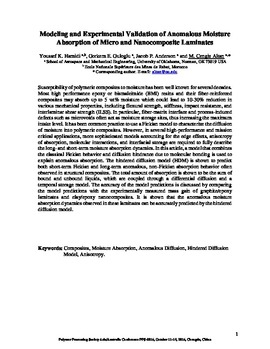| dc.contributor.author | Hamidi, Youssef K. | |
| dc.contributor.author | Guloglu, Gorkem E. | |
| dc.contributor.author | Anderson, Jacob P. | |
| dc.contributor.author | Altan, M. Cengiz | |
| dc.date.accessioned | 2016-08-18T16:33:44Z | |
| dc.date.available | 2016-08-18T16:33:44Z | |
| dc.date.issued | 2016 | |
| dc.identifier.citation | Y.K. Hamidi, G.E. Guloglu, J.P. Anderson and M.C. Altan. Modeling and Experimental Validation of Anomalous Moisture Absorption of Micro and Nanocomposite Laminates. Proceedings of the Polymer Processing Society Asia/Australia Conference PPS-2016, October 11-14, 2016, Chengdu, China | en_US |
| dc.identifier.uri | https://hdl.handle.net/11244/44913 | |
| dc.description.abstract | Susceptibility of polymeric composites to moisture has been well known for several decades. Most high performance epoxy or bismaleimide (BMI) resins and their fiber-reinforced composites may absorb up to 5 wt% moisture which could lead to 10-30% reduction in various mechanical properties, including flexural strength, stiffness, impact resistance, and interlaminar shear strength (ILSS). In particular, fiber-matrix interface and process-induced defects such as microvoids often act as moisture storage sites, thus increasing the maximum intake level. It has been common practice to use a Fickian model to characterize the diffusion of moisture into polymeric composites. However, in several high-performance and mission critical applications, more sophisticated models accounting for the edge effects, anisotropy of absorption, molecular interactions, and interfacial storage are required to fully describe the long- and short-term moisture absorption dynamics. In this article, a model that combines the classical Fickian behavior and diffusion hindrance due to molecular bonding is used to explain anomalous absorption. The hindered diffusion model (HDM) is shown to predict both short-term Fickian and long-term anomalous, non-Fickian absorption behavior often observed in structural composites. The total amount of absorption is shown to be the sum of bound and unbound liquids, which are coupled through a differential diffusion and a temporal storage model. The accuracy of the model predictions is discussed by comparing the model predictions with the experimentally measured mass gain of graphite/epoxy laminates and clay/epoxy nanocomposites. It is shown that the anomalous moisture absorption dynamics observed in these laminates can be accurately predicted by the hindered diffusion model. | en_US |
| dc.language | en_US | en_US |
| dc.title | Modeling and Experimental Validation of Anomalous Moisture Absorption of Micro and Nanocomposite Laminates | en_US |
| dc.type | Other | en_US |
| dc.description.peerreview | Yes | en_US |
| dc.description.peerreviewnotes | Polymer Processing Society Asia/Australia Conference PPS-2016, October 11-14, 2016, Chengdu, China | en_US |
| ou.group | College of Engineering::School of Aerospace and Mechanical Engineering | en_US |
